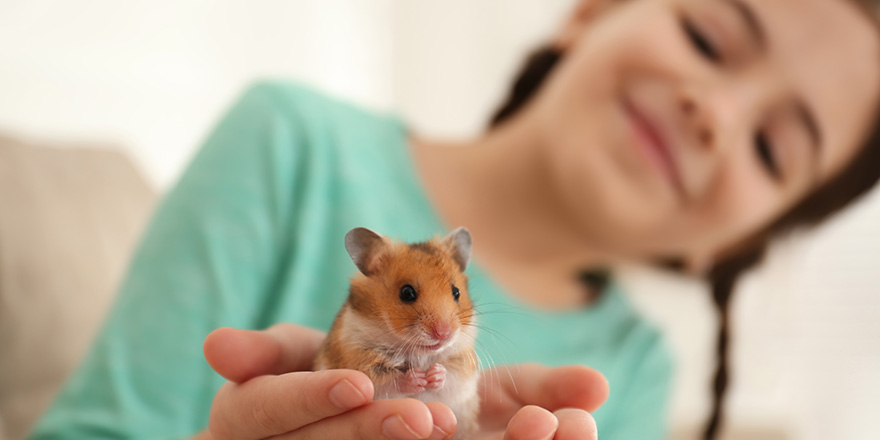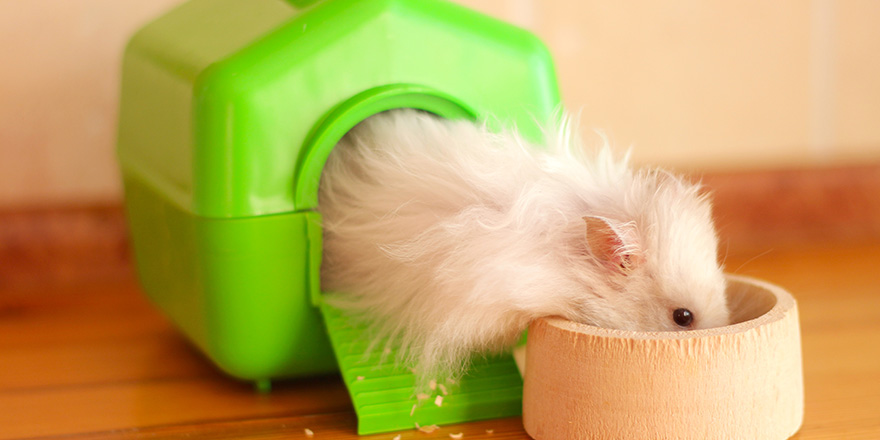A hamster is an adorable pet for any household. They take up very little space and are not that difficult to look after but are they good company? Do hamsters like to be held and is there anything that you can do to make your little friend feel more comfortable with human physical contact.
We love hamsters and have owned many ourselves so here we share our experiences with you together with extensive research and advice from hamster experts!
Do Hamsters Like Being Held?
Hamster owners often worry about this question especially if they have never owned a hamster before. The overall answer is yes, they do! However, this does not mean that you can just reach right into the cage and grab your hamster and expect it to go well. It won’t! You have to lead up to it correctly and take the time to make your hammy feel comfortable and confident with human contact.
Once you earn your hamster’s trust you will soon find that they enjoy your company and being held by you.

What You Need to Know Before Holding a Hamster
If you want your hamster petting experience to go well, you need the right hamster in the right environment at the right time. Then you need the correct technique. We’ve broken down this information to explain what we mean.
Which Hamsters Like to be Held?
The most common types of pet hamsters are Syrian hamsters and Dwarf (Campbell or Roborovski) hamsters. Syrian hamsters are solitary animals so you will only have one in the cage. They are intelligent creatures and many can be welcoming towards human interaction. Because they live on their own, their human family are their only company. They are also more robust hamsters as they are larger and move relatively slowly. But be warned, this is still quite fast. If holding your hamster is a priority for you, these would be your best choice of pet.
As their name suggests, Dwarf hamsters are very small! They are a delicate and sensitive creature and can very easily get hurt. They like to live in groups and the sad truth is that they would prefer to spend time with other hamsters than with you. They also move very fast which makes them more challenging to hold. Having said that, with the correct training and a lot of patience, it is possible to hold a Dwarf hamster successfully too.
When is the Best Time to Hold a Hamster?
Hamsters are not really nocturnal animals. They are most active at dawn and dusk which makes them crepuscular. This is the best time to try and interact with them. Never disturb a hamster when they are sleeping. Remember that they are prey animals and in their half-asleep state they will assume that you have come to attack them. This can result in a sharp bite. Whilst a hamster is unlikely to be able to inflict a serious injury, they can give you a nasty nip which is particularly damaging and painful for children’s small fingers. There is a lot more advice on how to stop your hamster from biting in our article that you can find here.
Do not try to handle your hamster straight away when you first bring your hamster home. It’s understandable that pet owners want to greet their new pet but this is a very stressful time for your new furry friend. Let your hamster explore their new environment first and get used to the smells and noises of their new house. It will only take a few days for your new hamster to become more confident.
Creating a Calm Hamster Environment
Your pet hamster will enjoy (or at least tolerate) being handled more readily if their environment is calm and suitable. Both when they are being handled and the rest of the time. The first thing you need to do to prevent a hamster from experiencing stress is provide them with a suitable cage. We have provided lots of advice on how to choose your hamster’s cage here.
The cage must be large enough to keep your hamster comfortable, have a wheel for exercise and lots of other toys. Hamsters that are stuck in tiny cages are always stressed. The cage bars must be close enough to stop them from escaping. They also need appropriate food, toys and a water bottle.
When handling your hamster it is important that both you and they feel relaxed. Use a soft voice and do not make any sudden movements. Hamsters have fairly poor eyesight and get very startled by loud noises and quick movements. Keep other pets, especially boisterous dogs, out of the way.
Step-by-Step Guide to Petting Your Hamster
Before you try to hold your hamster, spend some time getting them used to your hands. Then they will not feel uncomfortable about being held and the petting process should run more smoothy. There’s plenty more information on how to tame a hamster here.
Step 1: Give your hands a hamster smell. A hamster likes things that smells like him so wash your hands with unscented soap and then rub your hands in the bedding in the cage. You need to wash your hands to get rid of pathogens that could harm your hamster and smells of food and chemicals. Do this every time you handle your little pet.
Step2: Try some hand feeding. This is a great way to spend quality time with your pet. Let your hamster take a treat from your hand. Most hamsters love chopped cucumber or a small bit of apple. Alternatively, check out our article on hamster treats. Do this at least once a day for a few days and then start to talk to them in a soothing voice as they take the treat.
Step3: Once your little pet is used to taking food from your hand, they are ready to be held. You do this by scooping them up in cupped hands. Make your movements slow and calm but confident. It may be best to place the cage on the floor the first time you do this just in case you accidentally drop your hamster.
Step 4: Now you can use the other hand to pet your hamster along their back starting at the hamster’s head. Look out for how your hamster reacts – signs that they are either enjoying the petting or that they are not happy. If hamsters love petting they often wiggle their ears and have a relaxed posture. They may even nestle into your hand.
Do Hamsters Like to be Petted?
Hamsters do quite like us humans and even though they are a small animal they can form bonds with their human parents. Hamster’s fur is soft and fine and is nice to pet but not all hamsters will enjoy it. It is very important that you use only delicate strokes and do not hold your hamster too firmly as they can easily get injured.
Hamsters are not known for showing affection but they will recognize the voice of their pet parents and respond to you. Even if you cannot properly pet your hamster or hold your hamster close you can still enjoy feeding and interacting with them

Top Tips on Holding and Petting Hamsters.
Here are our top tips on how to hold and pet your hamster.
- Handle one hamster only: If you have several hamsters, only handle one hamster at a time. This will allow you to focus on one hamster and ensure that they feel comfortable.
- Supervise young children: Young children should always be supervised when they are handling hamsters. This is for the safety of the hamster and the child.
- Look for signs of distress: If your hamster starts to squeak, claw, hiss or bite, put them back in their cage and go back to hand feeding for a while.
- Handle your hamster every day: You cannot ignore your hamster all week and then expect to pet them at weekends. You need to handle them everyday so that they will become accustomed to it.
- Start slowly: At first, hold your little pets for just a few seconds. Then gradually build up. Most pets respond to gradual training and a hamster is no different.
Why it is Important to Hold Your Hamster
Getting little pets used to being held is not just about you having fun. Small animals can find it very stressful to be examined by a vet if they are not used to it. If you handle your hammy regularly, they will not be so stressed if you have to take them to the vet.
It also gives you a chance to check them over for lumps and bumps or other signs of injury or disease. Finally, it means that you can easily move them to another location whilst you give their cage a good clean out.
Have fun holding your hamster!







